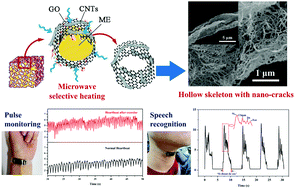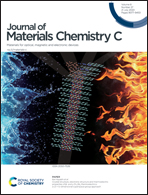Microwave-assisted selective heating to rapidly construct a nano-cracked hollow sponge for stretch sensing†
Abstract
Creating various fractured micro- and/or nano-structures in sponge-like conductive networks is a promising strategy for fabricating highly sensitive sensors. However, these structural designs will always involve complicated and time-consuming procedures, which severely hinder the application and development of the as-prepared sensors. Herein, an ultrafast and eco-friendly method assisted by microwave (MW) selective heating was proposed to prepare a highly sensitive sensing material, which facilitated the simultaneous reduction of graphene oxide (GO) and formation of a nano-fractured structure. A three-dimensional (3D) conductive network was first constructed by depositing GO and carbon nanotubes (CNTs) on a melamine (ME) sponge. The structural evolution of this coated GO/CNT@ME sponge during MW irradiation was thoroughly investigated. The uniformly distributed CNT served as the MW absorber, and was selectively and rapidly heated upon exposure to MW irradiation. The formed localized “hot spot” (nano-CNT) induced the degradation of the ME skeleton and the in situ reduction of GO, resulting in the construction of a 3D hollow sponge based on micro-fractured backbones covered with nano-voids in just 10 seconds. The final sensor was integrated using this cracked skeleton as the core framework and elastic polydimethylsiloxane (PDMS) as the packaging matrix. Benefitting from this unique multi-level structure, the resultant sensor exhibited an excellent electrical response to mechanical stretching with a wide strain range of 1–50% and a frequency range of 0.05–1 Hz. Besides, these flexible sensors were endowed with good stability and long-term reproducibility over 10 000 cycles. This study also demonstrated the versatile applications of these sensors in distinguishing large- and tiny-scale human motions, including finger bending, pulse beating and vocal vibrations. Thus, this advanced flexible and sensitive sensing material showed great potential in fields of human–machine interaction, health care and wearable devices.



 Please wait while we load your content...
Please wait while we load your content...